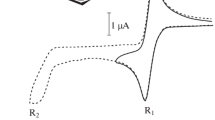Abstract
1,2- and 1,3-Dichloropropane react with clean titanium at ambient temperature to yield propylene, and a mixture of propylene (10%) and cyclopropane (90%), respectively. The surface is poisoned by adsorbed halide against further reaction at ambient temperature, but for temperatures > 150°C, a continuing dehalogenation reaction occurs with formation of titanium halide and the same unsaturated hydrocarbons as those formed at a clean surface. The high-temperature reactions obey a half-order rate law in reactant and have activation energies of 24 and 28 kcal/mole for the 1,2- and 1,3-dihalides, respectively.
Similar content being viewed by others
References
J. F. Harrod and W. R. Summers,J. Am. Chem. Soc. 93, 5051 (1971).
W. R. Summers and J. F. Harrod,Can. J. Chem. 50, 2167 (1972).
R. W. Roberts and R. S. Owens,Nature 200, 357 (1963);J Sci. 2, 69 (1966).
Author information
Authors and Affiliations
Additional information
This work was done in partial fulfillment of the requirements for a Ph.D. thesis (W.R.S.).
National Research Council of Canada Scholar 1969–1970.
Rights and permissions
About this article
Cite this article
Harrod, J.F., Summers, W.R. Chemistry of transition metals. III. Reactions of some alkyl dichlorides with titanium. Oxid Met 6, 117–121 (1973). https://doi.org/10.1007/BF00614659
Received:
Issue Date:
DOI: https://doi.org/10.1007/BF00614659




